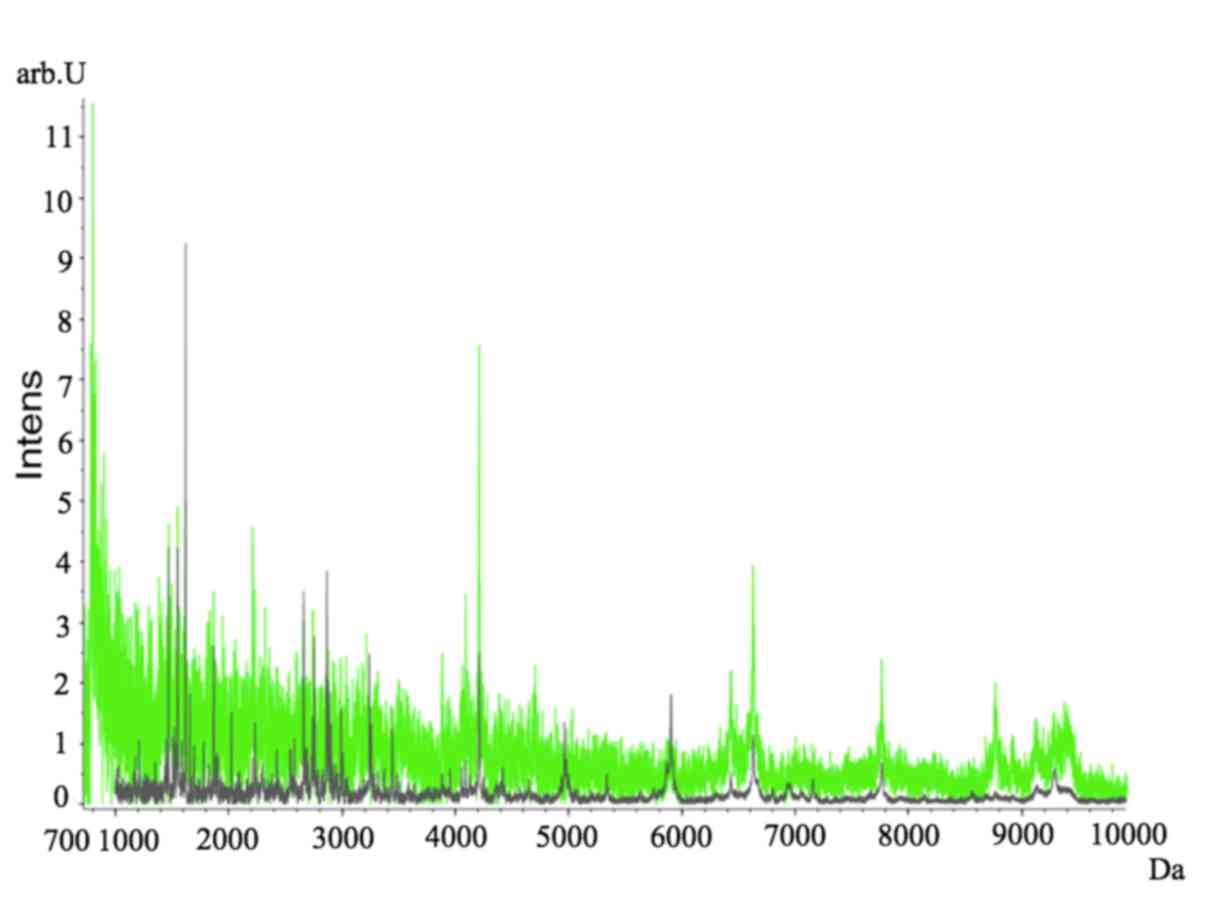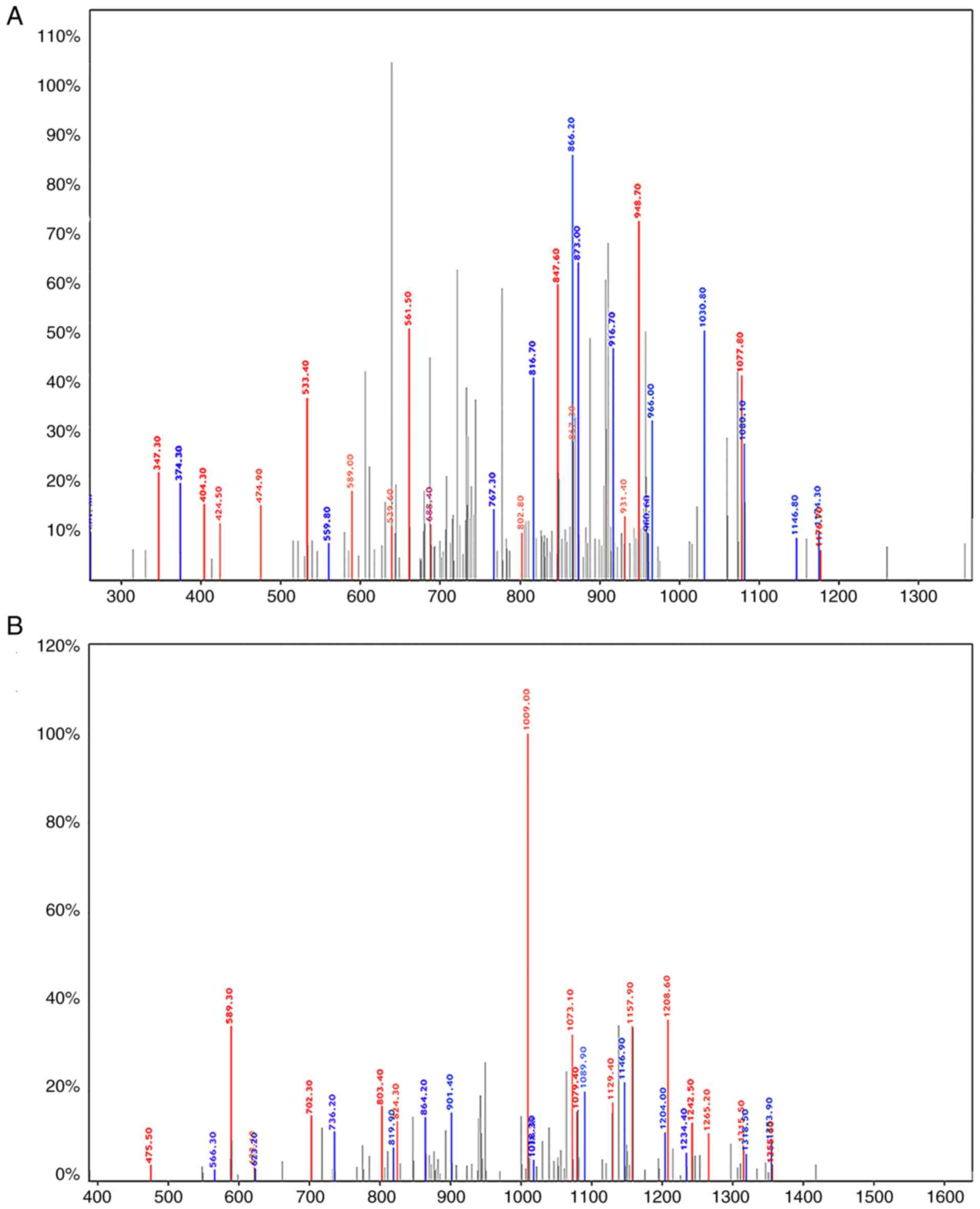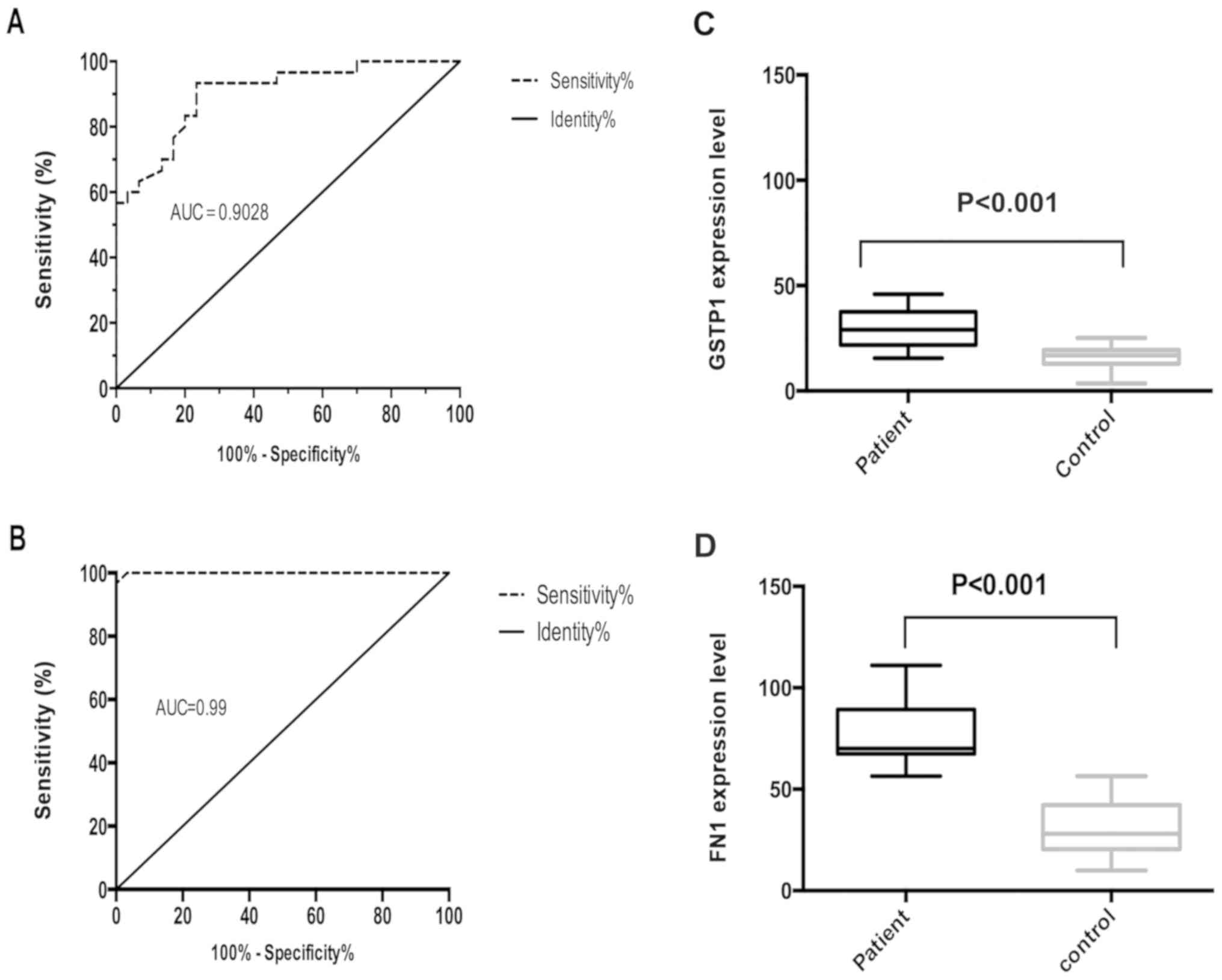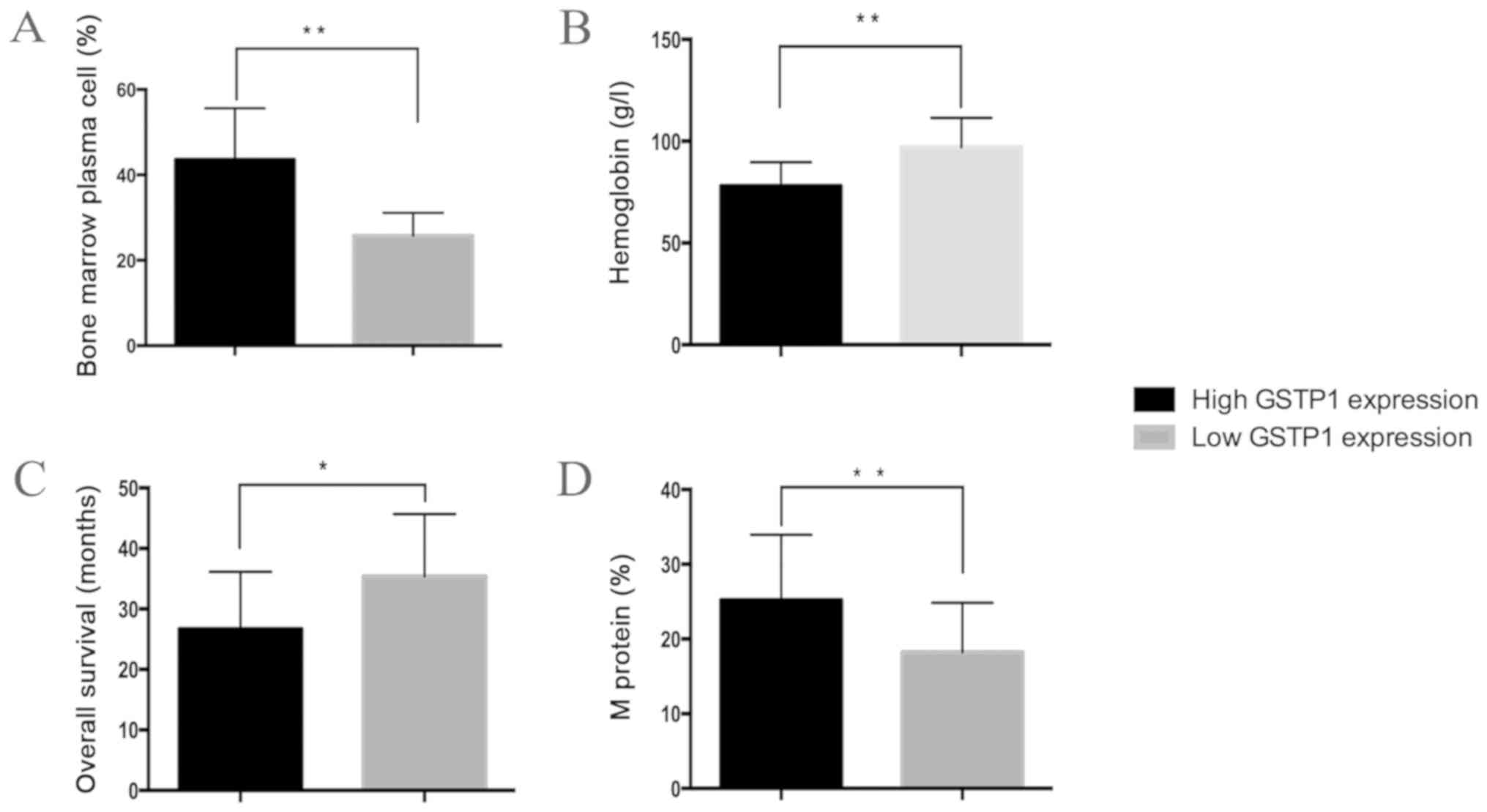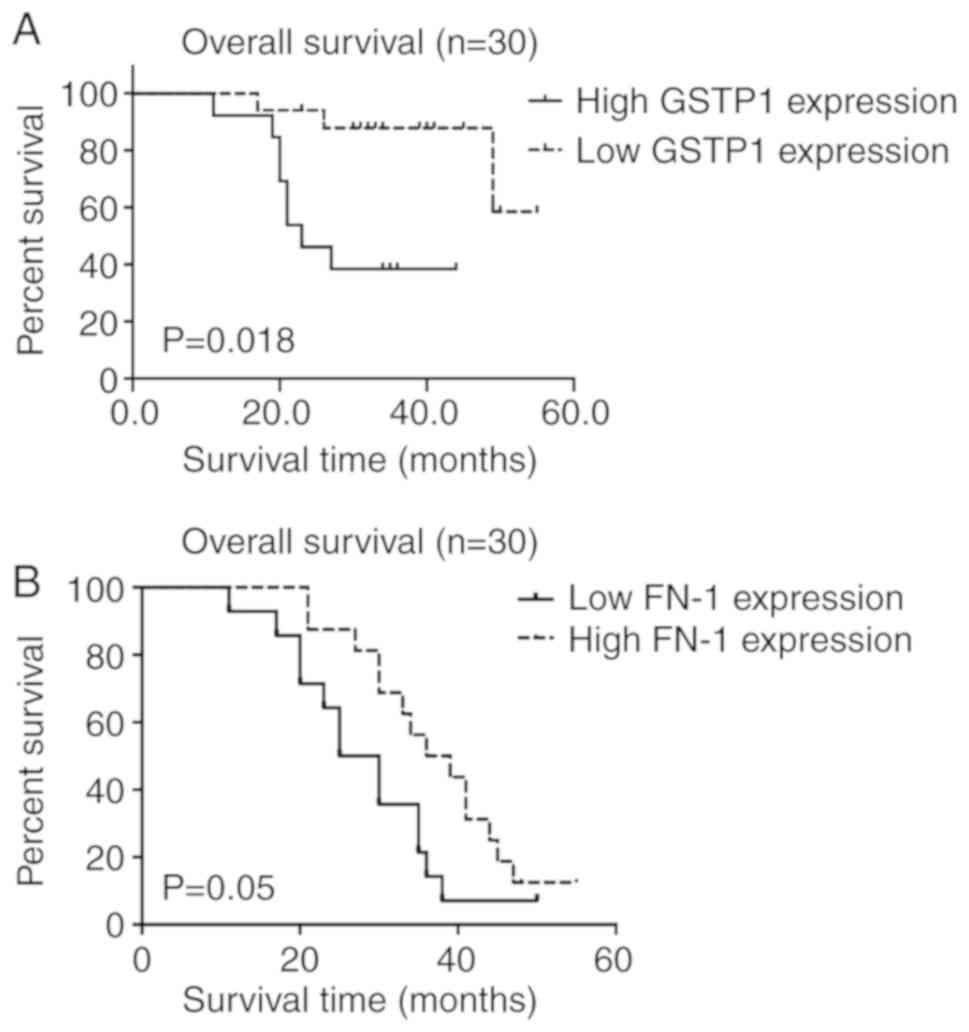|
1
|
Siegel RL, Miller KD and Jemal A: Cancer
statistics, 2016. CA Cancer J Clin. 66:7–30. 2016. View Article : Google Scholar : PubMed/NCBI
|
|
2
|
Kumar SK, Rajkumar V, Kyle RA, van Duin M,
Sonneveld P, Mateos MV, Gay F and Anderson KC: Multiple myeloma.
Nat Rev Dis Primers. 3:170462017. View Article : Google Scholar : PubMed/NCBI
|
|
3
|
Durie BGM, Hoering A, Abidi MH, Rajkumar
SV, Epstein J, Kahanic SP, Thakuri M, Reu F, Reynolds CM, Sexton R,
et al: Bortezomib with lenalidomide and dexamethasone versus
lenalidomide and dexamethasone alone in patients with newly
diagnosed myeloma without intent for immediate autologous stem-cell
transplant (SWOG S0777): A randomised, open-label, phase 3 trial.
Lancet. 389:519–527. 2017. View Article : Google Scholar : PubMed/NCBI
|
|
4
|
Abe M, Harada T and Matsumoto T: Concise
review: Defining and targeting myeloma stem cell-like cells. Stem
Cells. 32:1067–1073. 2014. View Article : Google Scholar : PubMed/NCBI
|
|
5
|
Kyle RA, Remstein ED, Therneau TM,
Dispenzieri A, Kurtin PJ, Hodnefield JM, Larson DR, Plevak MF,
Jelinek DF, Fonseca R, et al: Clinical course and prognosis of
smoldering (asymptomatic) multiple myeloma. N Engl J Med.
356:2582–2590. 2007. View Article : Google Scholar : PubMed/NCBI
|
|
6
|
Zhan F, Hardin J, Kordsmeier B, Bumm K,
Zheng M, Tian E, Sanderson R, Yang Y, Wilson C, Zangari M, et al:
Global gene expression profiling of multiple myeloma, monoclonal
gammopathy of undetermined significance, and normal bone marrow
plasma cells. Blood. 99:1745–1757. 2002. View Article : Google Scholar : PubMed/NCBI
|
|
7
|
Landgren O, Kyle RA, Pfeiffer RM, Katzmann
JA, Caporaso NE, Hayes RB, Dispenzieri A, Kumar S, Clark RJ, Baris
D, et al: Monoclonal gammopathy of undetermined significance (MGUS)
consistently precedes multiple myeloma: A prospective study. Blood.
113:5412–5417. 2009. View Article : Google Scholar : PubMed/NCBI
|
|
8
|
Chee CE, Kumar S, Larson DR, Kyle RA,
Dispenzieri A, Gertz MA, Colby CL and Rajkumar SV: The importance
of bone marrow examination in determining complete response to
therapy in patients with multiple myeloma. Blood. 114:2617–2618.
2009. View Article : Google Scholar : PubMed/NCBI
|
|
9
|
Durie BG, Harousseau JL, Miguel JS, Bladé
J, Barlogie B, Anderson K, Gertz M, Dimopoulos M, Westin J,
Sonneveld P, et al: International uniform response criteria for
multiple myeloma. Leukemia. 20:1467–1473. 2006. View Article : Google Scholar : PubMed/NCBI
|
|
10
|
Kumar S, Paiva B, Anderson KC, Durie B,
Landgren O, Moreau P, Munshi N, Lonial S, Bladé J, Mateos MV, et
al: International myeloma working group consensus criteria for
response and minimal residual disease assessment in multiple
myeloma. Lancet Oncol. 17:e328–e346. 2016. View Article : Google Scholar : PubMed/NCBI
|
|
11
|
Durie BG and Salmon SE: A clinical staging
system for multiple myeloma. Correlation of measured myeloma cell
mass with presenting clinical features, response to treatment, and
survival. Cancer. 36:842–854. 1975. View Article : Google Scholar : PubMed/NCBI
|
|
12
|
Greipp PR, Miguel JS, Durie BG, Crowley
JJ, Barlogie B, Bladé J, Boccadoro M, Child JA, Avet-Loiseau H,
Kyle RA, et al: International staging system for multiple myeloma.
J Clin Oncol. 23:3412–3420. 2005. View Article : Google Scholar : PubMed/NCBI
|
|
13
|
Morgan GJ, Walker BA and Davies FE: The
genetic architecture of multiple myeloma. Nat Rev Cancer.
12:335–348. 2012. View
Article : Google Scholar : PubMed/NCBI
|
|
14
|
Hideshima T, Mitsiades C, Tonon G,
Richardson PG and Anderson KC: Understanding multiple myeloma
pathogenesis in the bone marrow to identify new therapeutic
targets. Nat Rev Cancer. 7:585–598. 2007. View Article : Google Scholar : PubMed/NCBI
|
|
15
|
Tsai TH, Song E, Zhu R, Di Poto C, Wang M,
Luo Y, Varghese RS, Tadesse MG, Ziada DH, Desai CS, et al:
LC-MS/MS-based serum proteomics for identification of candidate
biomarkers for hepatocellular carcinoma. Proteomics. 15:2369–2381.
2015. View Article : Google Scholar : PubMed/NCBI
|
|
16
|
Srinivas PR, Verma M, Zhao Y and
Srivastava S: Proteomics for cancer biomarker discovery. Clin Chem.
48:1160–1169. 2002.PubMed/NCBI
|
|
17
|
International Myeloma Working Group, :
Criteria for the classification of monoclonal gammopathies,
multiple myeloma and related disorders: A report of the
international myeloma working group. Br J Haematol. 121:749–757.
2003. View Article : Google Scholar : PubMed/NCBI
|
|
18
|
Dhodapkar MV: MGUS to myeloma: A
mysterious gammopathy of underexplored significance. Blood.
128:2599–2609. 2016. View Article : Google Scholar : PubMed/NCBI
|
|
19
|
Rajkumar SV, Mesa RA, Fonseca R, Schroeder
G, Plevak MF, Dispenzieri A, Lacy MQ, Lust JA, Witzig TE, Gertz MA,
et al: Bone marrow angiogenesis in 400 patients with monoclonal
gammopathy of undetermined significance, multiple myeloma, and
primary amyloidosis. Clin Cancer Res. 8:2210–2216. 2002.PubMed/NCBI
|
|
20
|
Szalat R, Avet-Loiseau H and Munshi NC:
Gene expression profiles in myeloma: Ready for the real world? Clin
Cancer Res. 22:5434–5442. 2016. View Article : Google Scholar : PubMed/NCBI
|
|
21
|
Hristova VA and Chan DW: Cancer biomarker
discovery and translation: Proteomics and beyond. Expert Rev
Proteomics. 16:93–103. 2019. View Article : Google Scholar : PubMed/NCBI
|
|
22
|
Sahu A and Lambris JD: Structure and
biology of complement protein C3, a connecting link between innate
and acquired immunity. Immunol Rev. 180:35–48. 2001. View Article : Google Scholar : PubMed/NCBI
|
|
23
|
Nilsson B and Nilsson Ekdahl K: The
tick-over theory revisited: Is C3 a contact-activated protein?
Immunobiology. 217:1106–1110. 2012. View Article : Google Scholar : PubMed/NCBI
|
|
24
|
Ricklin D, Reis ES, Mastellos DC, Gros P
and Lambris JD: Complement component C3-The ‘Swiss Army Knife’ of
innate immunity and host defense. Immunol Rev. 274:33–58. 2016.
View Article : Google Scholar : PubMed/NCBI
|
|
25
|
Delanghe JR, Speeckaert R and Speeckaert
MM: Complement C3 and its polymorphism: Biological and clinical
consequences. Pathology. 46:1–10. 2014. View Article : Google Scholar : PubMed/NCBI
|
|
26
|
Wlazlo N, van Greevenbroek MM, Ferreira I,
Jansen EJ, Feskens EJ, van der Kallen CJ, Schalkwijk CG, Bravenboer
B and Stehouwer CD: Low-grade inflammation and insulin resistance
independently explain substantial parts of the association between
body fat and serum C3: The CODAM study. Metabolism. 61:1787–1796.
2012. View Article : Google Scholar : PubMed/NCBI
|
|
27
|
Van Timmeren MM, Chen M and Heeringa P:
Review article: Pathogenic role of complement activation in
anti-neutrophil cytoplasmic auto-antibody-associated vasculitis.
Nephrology (Carlton). 14:16–25. 2009. View Article : Google Scholar : PubMed/NCBI
|
|
28
|
Cerhan JR, Novak AJ, Fredericksen ZS, Wang
AH, Liebow M, Call TG, Dogan A, Witzig TE, Ansell SM, Habermann TM,
et al: Risk of non-Hodgkin lymphoma in association with germline
variation in complement genes. Br J Haematol. 145:614–623. 2009.
View Article : Google Scholar : PubMed/NCBI
|
|
29
|
Sponziello M, Rosignolo F, Celano M,
Maggisano V, Pecce V, De Rose RF, Lombardo GE, Durante C, Filetti
S, Damante G, et al: Fibronectin-1 expression is increased in
aggressive thyroid cancer and favors the migration and invasion of
cancer cells. Mol Cell Endocrinol. 431:123–132. 2016. View Article : Google Scholar : PubMed/NCBI
|
|
30
|
Gao W, Liu Y, Qin R, Liu D and Feng Q:
Silence of fibronectin 1 increases cisplatin sensitivity of
non-small cell lung cancer cell line. Biochem Biophys Res Commun.
476:35–41. 2016. View Article : Google Scholar : PubMed/NCBI
|
|
31
|
Wang J, Deng L, Huang J, Cai R, Zhu X, Liu
F, Wang Q, Zhang J and Zheng Y: High expression of Fibronectin 1
suppresses apoptosis through the NF-κB pathway and is associated
with migration in nasopharyngeal carcinoma. Am J Transl Res.
9:4502–4511. 2017.PubMed/NCBI
|
|
32
|
Li B, Shen W, Peng H, Li Y, Chen F, Zheng
L, Xu J and Jia L: Fibronectin 1 promotes melanoma proliferation
and metastasis by inhibiting apoptosis and regulating EMT. Onco
Targets Ther. 12:3207–3221. 2019. View Article : Google Scholar : PubMed/NCBI
|
|
33
|
Xia S, Wang C, Postma EL, Yang Y, Ni X and
Zhan W: Fibronectin 1 promotes migration and invasion of papillary
thyroid cancer and predicts papillary thyroid cancer lymph node
metastasis. Onco Targets Ther. 10:1743–1755. 2017. View Article : Google Scholar : PubMed/NCBI
|
|
34
|
Ma LJ, Lee SW, Lin LC, Chen TJ, Chang IW,
Hsu HP, Chang KY, Huang HY and Li CF: Fibronectin overexpression is
associated with latent membrane protein 1 expression and has
independent prognostic value for nasopharyngeal carcinoma. Tumour
Biol. 35:1703–1712. 2014. View Article : Google Scholar : PubMed/NCBI
|
|
35
|
Jerhammar F, Ceder R, Garvin S, Grénman R,
Grafström RC and Roberg K: Fibronectin 1 is a potential biomarker
for radioresistance in head and neck squamous cell carcinoma.
Cancer Biol Ther. 10:1244–1251. 2010. View Article : Google Scholar : PubMed/NCBI
|
|
36
|
Yi W, Xiao E, Ding R, Luo P and Yang Y:
High expression of fibronectin is associated with poor prognosis,
cell proliferation and malignancy via the NF-κB/p53-apoptosis
signaling pathway in colorectal cancer. Oncol Rep. 36:3145–3153.
2016. View Article : Google Scholar : PubMed/NCBI
|
|
37
|
Townsend DM and Tew KD: The role of
glutathione-S-transferase in anti-cancer drug resistance. Oncogene.
22:7369–7375. 2003. View Article : Google Scholar : PubMed/NCBI
|
|
38
|
Strange RC, Spiteri MA, Ramachandran S and
Fryer AA: Glutathione-S-transferase family of enzymes. Mutat Res.
482:21–26. 2001. View Article : Google Scholar : PubMed/NCBI
|
|
39
|
Adler V, Yin Z, Fuchs SY, Benezra M,
Rosario L, Tew KD, Pincus MR, Sardana M, Henderson CJ, Wolf CR, et
al: Regulation of JNK signaling by GSTp. EMBO J. 18:1321–1334.
1999. View Article : Google Scholar : PubMed/NCBI
|
|
40
|
Ding H, Liu W, Yu X, Wang L, Shao L and Yi
W: Risk association of meningiomas with MTHFR C677T and GSTs
polymorphisms: A meta-analysis. Int J Clin Exp Med. 7:3904–3914.
2014.PubMed/NCBI
|
|
41
|
Tew KD, Manevich Y, Grek C, Xiong Y, Uys J
and Townsend DM: The role of glutathione S-transferase P in
signaling pathways and S-glutathionylation in cancer. Free Radic
Biol Med. 51:299–313. 2011. View Article : Google Scholar : PubMed/NCBI
|
|
42
|
Wang R, Liu C, Xia L, Zhao G, Gabrilove J,
Waxman S and Jing Y: Ethacrynic acid and a derivative enhance
apoptosis in arsenic trioxide-treated myeloid leukemia and lymphoma
cells: The role of glutathione S-transferase p1-1. Clin Cancer Res.
18:6690–6701. 2012. View Article : Google Scholar : PubMed/NCBI
|
|
43
|
Emadi A and Karp JE: The clinically
relevant pharmacogenomic changes in acute myelogenous leukemia.
Pharmacogenomics. 13:1257–1269. 2012. View Article : Google Scholar : PubMed/NCBI
|















